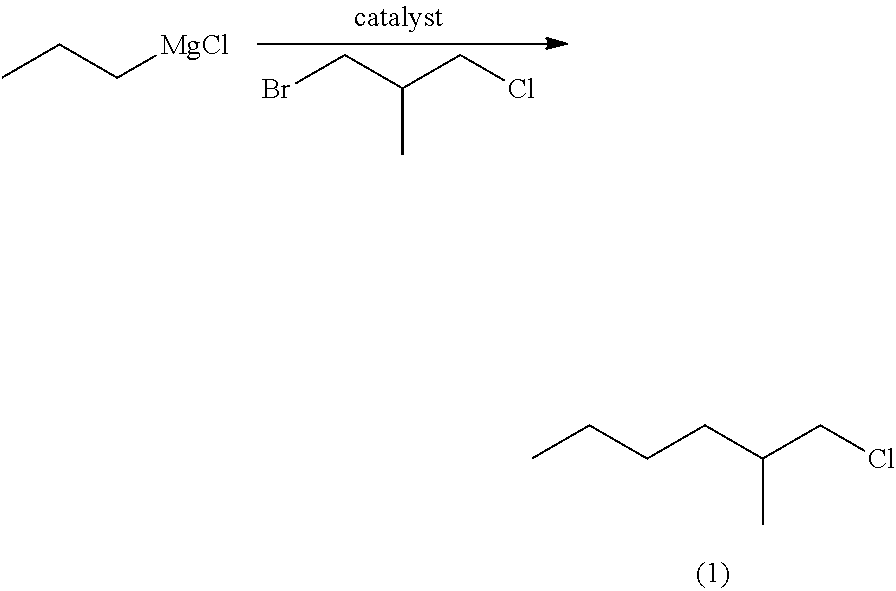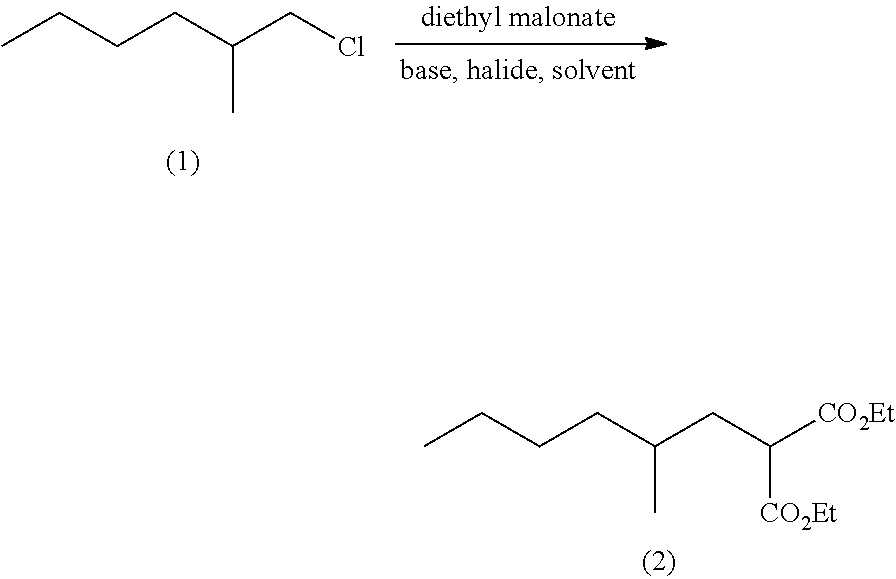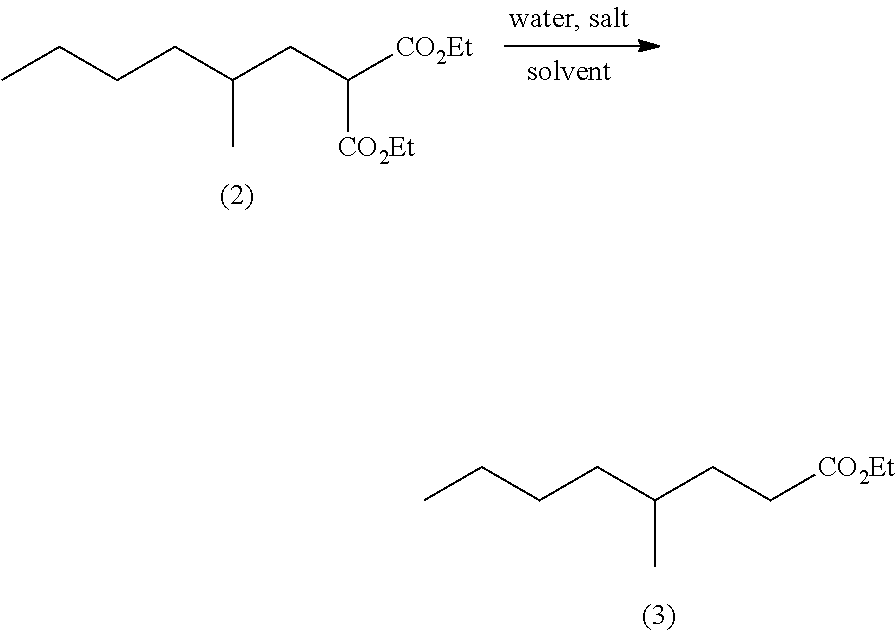Method for producing ethyl 4-methyloctanoate
a technology of ethyl 4methyloctanoate and ethyl 4methyloctanoate, which is applied in the preparation of carboxylic acid esters, chemistry apparatus and processes, and organic chemistry, etc. it can solve the problems of difficult separation through distillation, inconvenient industrial production, and difficult handling, so as to achieve low cost and fewer steps. , the effect of high yield
- Summary
- Abstract
- Description
- Claims
- Application Information
AI Technical Summary
Benefits of technology
Problems solved by technology
Method used
Image
Examples
example 1
Production of diethyl 2-methylhexylmalonate
[0025]Sodium ethoxide (93.57 g, 1.38 mol), potassium iodide (1.83 g, 0.011 mol), N,N-dimethylacetamide (770 g) and tetrahydrofuran (330 g) were placed in a reactor at room temperature, and stirred at 25° C. for 30 minutes. After stirring, diethyl malonate (220.23 g, 1.38 mol) was dropwise added thereto at 60° C. or less, and the resulting mixture was stirred at 70° C. for 1.5 hours. Then 1-chloro-2-methylhexane (148.12 g, 1.10 mol) was dropwise added thereto at 70° C. The resulting mixture was then refluxed at 89° C. with stirring for 35 hours. After the reaction mixture was cooled to 50° C. or less, hexane (220 g) and water (880 g) were added to the reaction mixture to terminate the reaction. The reaction mixture was separated into organic and water phases. The organic phase separated from the water phase was subjected to addition of water (880 g), and then separated again. The organic phase was concentrated under reduced pressure to remov...
example 2
Production of diethyl 2-methylhexylmalonate
[0029]Potassium t-butoxide (694.30 g, 6.19 mol), potassium iodide (164.35 g, 0.99 mol), N,N-dimethylacetamide (3465 g) and tetrahydrofuran (1485 g) were placed in a reactor at room temperature, and stirred at 25° C. for 30 minutes. After stirring, diethyl malonate (991.05 g, 6.19 mol) was dropwise added thereto at 60° C. or less and the resulting mixture was stirred at 70° C. for 30 minutes. Then 1-chloro-2-methylhexane (666.52 g, 4.95 mol) was dropwise added thereto at 90° C. or less. After completion of the dropwise addition, the resulting mixture was refluxed at 92° C. with stirring for 11 hours. After the reaction mixture was cooled to 50° C. or less, hexane (1485 g) and water (3960 g) were added to the reaction mixture to terminate the reaction. The reaction mixture was separated into organic and water phases. The organic phase separated from the water phase was subjected to addition of water (3960 g), and then separated again. The org...
example 3
Production of diethyl 2-methylhexylmalonate
[0033]Potassium carbonate (345.53 g, 2.50 mol), potassium iodide (3.32 g, 0.02 mol), N,N-dimethylacetamide (1400 g), diethyl malonate (480.51 g, 3.00 mol) and 1-chloro-2-methylhexane (269.30 g, 2.00 mol) were placed in a reactor at room temperature, and heated to 130° C. After the temperature reached 130° C., the resulting mixture was stirred for 7 hours. After the reaction mixture was cooled to 50° C. or less, hexane (400 g) and water (1600 g) were added to the reaction mixture to terminate the reaction. The reaction mixture was separated into organic and water phases. The organic phase separated from the water phase was subjected to addition of water (400 g), and then separated again. The organic phase was concentrated under reduced pressure to remove the hexane. The residue was distilled under reduced pressure to obtain diethyl 2-methylhexylmalonate (436. 61 g, 1.69 mol) in yield of 84.4%.
[0034][Nuclear magnetic resonance spectrum]1H-NMR...
PUM
 Login to View More
Login to View More Abstract
Description
Claims
Application Information
 Login to View More
Login to View More - R&D
- Intellectual Property
- Life Sciences
- Materials
- Tech Scout
- Unparalleled Data Quality
- Higher Quality Content
- 60% Fewer Hallucinations
Browse by: Latest US Patents, China's latest patents, Technical Efficacy Thesaurus, Application Domain, Technology Topic, Popular Technical Reports.
© 2025 PatSnap. All rights reserved.Legal|Privacy policy|Modern Slavery Act Transparency Statement|Sitemap|About US| Contact US: help@patsnap.com



